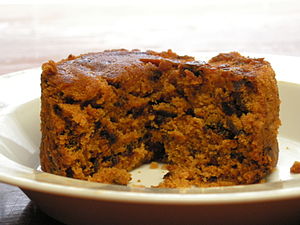Spotted dick
 Spotted dick | |
| Type | Pudding |
|---|---|
| Place of origin | United Kingdom |
| Main ingredients | Suet, dried fruit |
Spotted dick is a British pudding, made with suet and dried fruit (usually currants and/or raisins) and often served with custard.
It is made from a flat sheet of suet pastry sprinkled with dried fruit, which is then rolled up into a circular pudding.[1]
The dish is first attested in Alexis Soyer's The modern Housewife or ménagère, published in 1849, in which he described a recipe for "Plum Bolster, or Spotted Dick—Roll out two pounds of paste ... have some Smyrna raisins well washed...". The Pall Mall Gazette reported in 1892 that "the Kilburn Sisters ... daily satisfied hundreds of dockers with soup and Spotted Dick".[2]
The name has long been a source of amusement and double entendres, to the point that the catering staff of Flintshire County Council decided in 2009 to rename it to "Spotted Richard" because of all the jokes they were receiving.[2] While "spotted" is a clear reference to the dried fruit in the pudding (which resemble spots), "dick" is more obscure. The word was widely used as a term for pudding in the 19th century; in late 19th century Huddersfield, for instance, a glossary of local terms described "Dick, plain pudding. If with treacle sauce, treacle dick."[2] It could alternatively be a corruption of the word pudding, evolving through puddink, then puddick, then finally dick. Another possibility is that it is a corruption of "dough".[1]
See also
References
- ^ a b McCorquodale, Duncan (2009). A Visual History of Cookery. Black Dog. p. 142. ISBN 9781906155506.
- ^ a b c Ayto, John (2012). The Diner's Dictionary: Word Origins of Food and Drink. Oxford University Press. p. 349. ISBN 9780199640249.
